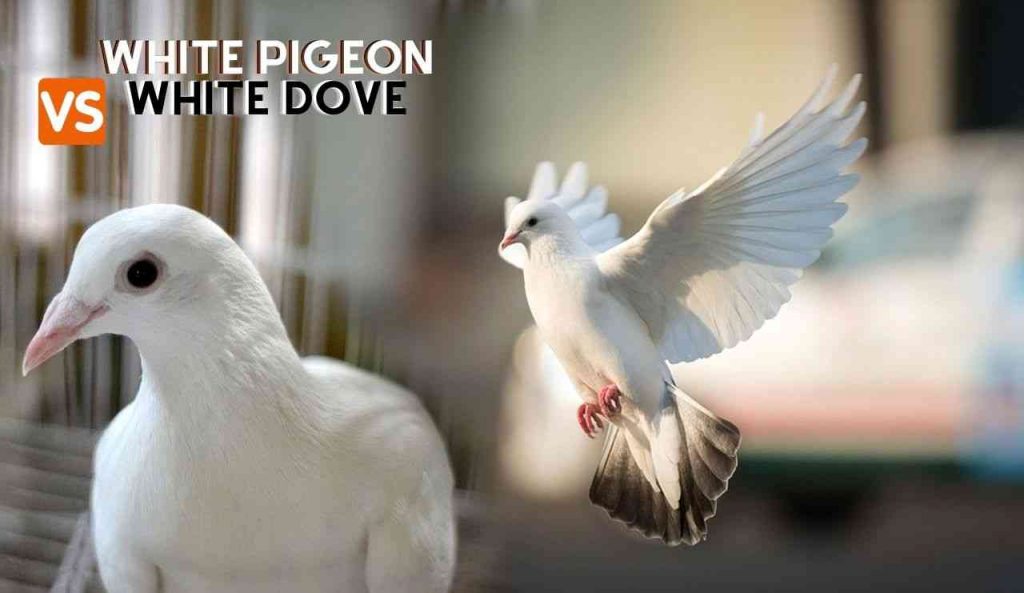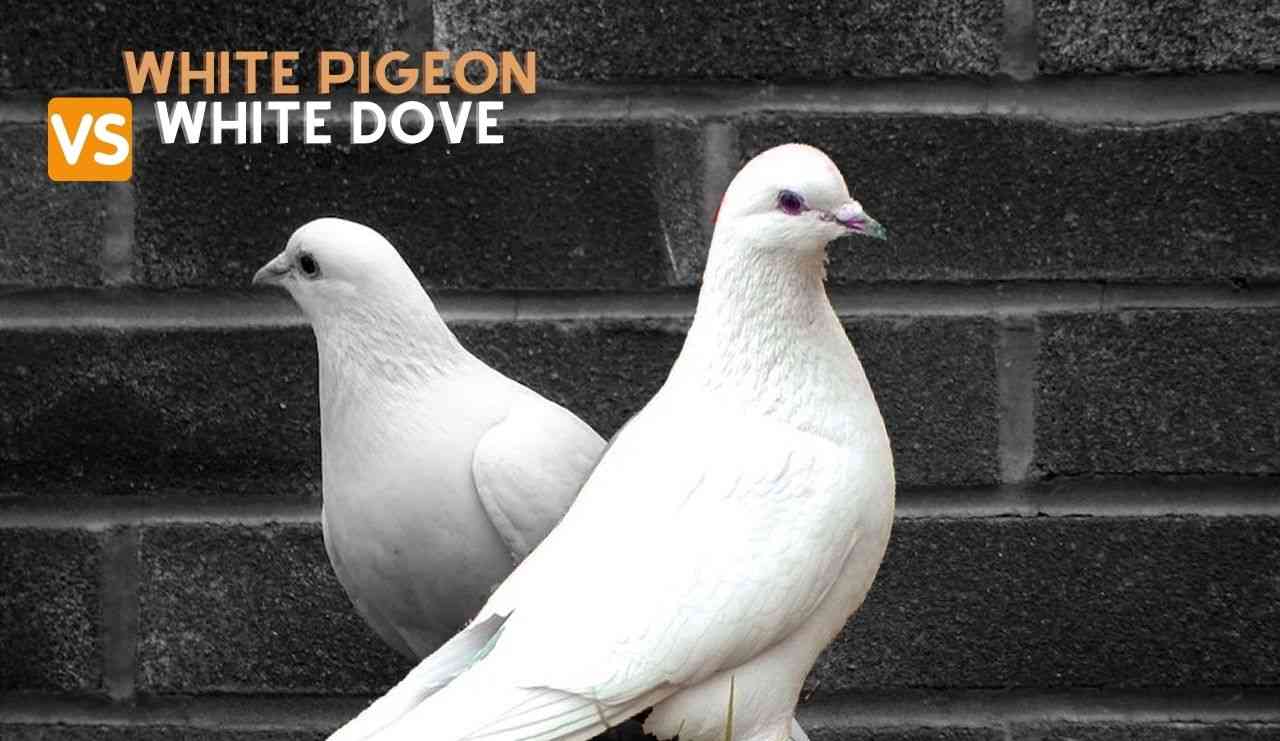At a glance, white doves and white pigeons appear quite similar. However, there are important distinctions between these two bird species in terms of taxonomy, physiology, behavior, habitat and symbolism. Read on to learn how white doves and white pigeons differ to gain a better understanding and appreciation of these misunderstood birds.
Taxonomy and Genetics
- White doves belong to the zoological family Columbidae, which includes 310 species of doves and pigeons.
- Most white doves are bred from domesticated Rock Pigeons (Columba livia). This wild pigeon species naturally occurs in white morphs.
- White pigeons are just feral Rock Pigeons that exhibit the white color variant.
- Doves tend to be smaller and slimmer with a delicate round head and pointed tail feathers.
- Pigeons are bulkier and sturdier with a larger blocky head shape and squared tail.
- Genetically, white doves and white pigeons are the same species. “Dove” is often used to indicate domestication.
Physiology and Markings
- White doves have been selectively bred to have a pure snowy white coloration on their plumage.
- White pigeons often retain some grey or black color in their wing and tail feathers from their wild ancestry.
- Doves have red or orange eyes, while pigeons are more likely to have yellow, grey, or dark eyes.
- Pigeons may exhibit some faint banding patterns on their wings leftover from ancestral rock pigeons.
- Doves weigh around 4-6 oz on average, while pigeons are closer to 8-14 oz in size.
- Pigeons have larger beaks and wattles used for digging seeds and regulating body temperature.
Key Physical Differences
| Characteristic | White Dove | White Pigeon |
|---|---|---|
| Size | Smaller, slimmer | Larger, stockier |
| Weight | 4-6 oz | 8-14 oz |
| Eyes | Orange or red | Yellow, grey, or black |
| Beak | Smaller and slimmer | Larger and sturdier |
| Tail feathers | Pointed | Squared |
| Wings | Lack banding | May show faint bands |

Behavior and Temperament
- White doves are bred to be docile with a pleasant disposition for handling by humans.
- White pigeons tend to be more wary as descendants of wild rock pigeons adapted for surviving outdoors.
- Doves exhibit weakened homing and navigation abilities compared to pigeons.
- Pigeons are more eager and competitive when feeding compared to mild-mannered doves.
- Doves are less vocal with simple coos, while pigeons make louder repetitive coos.
- Pigeons form large flocks for socializing and bathing, while doves associate in smaller groups.
- Doves roost communally inside shelters, whereas pigeons prefer tight clumps on exposed ledges.
Behavioral Comparison
| Behavior | White Dove | White Pigeon |
|---|---|---|
| Tameness | Docile, easy to handle | Wary, avoids humans |
| Homing ability | Weak, stays close to home | Strong, flies long distances |
| Feeding | Gentle, infrequent | Aggressive, constant |
| Vocalizations | Simple soft coos | Noisy repetitive coos |
| Flocking | Small groups | Large dense flocks |
| Roosting | Inside shelters | Exposed ledges |
Habitat and Range
- White doves are human-associated, typically living in or near barns, pens, and houses.
- White pigeons thrive in cities exploiting manmade structures. Feral populations revert to ancestral cliff sides.
- Doves avoid long distance flight, remaining close to their shelter and food source.
- Pigeons are strong fliers adapted for long urban commutes or migrations between wild cliff habitats.
- The white dove range depends on the locations they are raised and kept by humans.
- White pigeons occur worldwide in proximity to human settlements mimicking natural rock faces.
Symbolic Associations
- White doves represent peace, love, purity, and grace in Judeo-Christian and literary symbolism.
- White pigeons are associated with productive communication as messengers and wartime homing birds.
- Doves released at events symbolize the human spirit triumphing over adversity.
- Pigeons have reputations as hardy urban survivors able to thrive close to people.
- White doves imply simplification through domestication, whereas pigeons suggest wild complexity.
- Doves raise positive emotions, while urban pigeons are often viewed negatively as pests.
So in essence, white doves are genetically Rock Pigeons selectively bred for appearance and behavior to fill symbolic roles. White pigeons are feral city descendants of wild Rock Pigeons exhibiting ancestral traits adapted for thriving close to humans without active domestication. Remembering key differences provides deeper insight into these often-confused white birds.
FAQ
Are all white pigeons doves?
No, not all white pigeons are doves. Pigeons and doves are two different bird species, despite having similar appearances. With iridescence on their plumage, bigger beaks, and a louder, less melodious cooing voice, pigeons are often larger and stouter birds. Conversely, doves usually have thinner beaks without a hump at the base, are slenderer, and have a softer, higher-pitched cooing sound. They also don’t have iridescence. While a white pigeon and a dove may first seem similar, you may distinguish between the two by observing differences in size, body form, beak, and cooing sound.
Are doves and pigeons the same?
No, despite some similarities, doves and pigeons are not precisely the same. Pigeons are classified as members of the Columbinae subfamily of the Columbidae family, while doves are considered to be members of the family Columbidae. This implies that although pigeons are a kind of dove in theory, it’s crucial to remember that not all doves fall within this category. They belong to distinct categories within the Columbidae family.
Sources:
The British Trust for Ornithology
The Cornell Lab of Ornithology
- New Jersey Hunting Seasons 2024 New Dates & Regulations - September 15, 2024
- Delaware Hunting & Trapping Seasons Summary 2024 - September 4, 2024
- 2024-2025 Colorado Hunting: New Big Game Season Dates! - August 28, 2024





